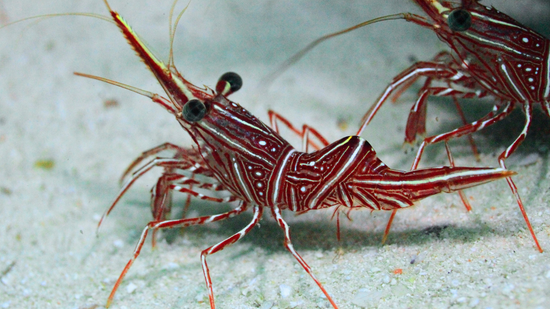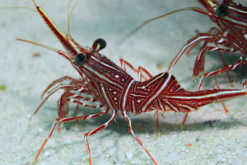Camelback Shrimp (Rhynchocinetes uritai)
Quick Stats:
- Care Level: Moderate
- Temperament: Peaceful
- Diet: Omnivore
- Reef Safe: Yes
- Minimum Tank Size: 10 gallons
- Maximum Size: 2 inches
- Water Parameters: pH 8.1-8.4, Salinity 1.023-1.025, Temperature 72-78°F
Comprehensive Guide: Camelback Shrimp (Rhynchocinetes uritai)
Habitat
The Camelback Shrimp, also known as Rhynchocinetes uritai, is native to the Indo-Pacific region, specifically found in the Western Pacific Ocean. It is commonly found in shallow reef areas, hiding among rocks and coral formations.
Reef Safe
The Camelback Shrimp is considered reef safe as it does not harm corals or other invertebrates. In fact, it is often regarded as a beneficial addition to a reef aquarium due to its cleaning behavior.
Reef Cleaner
The Camelback Shrimp is known for its cleaning behavior, where it will actively groom and remove parasites from fish and other tank inhabitants. It also helps to control algae growth by consuming various types of algae present in the aquarium.
Size
The Camelback Shrimp typically grows up to 2 inches in length, making it a relatively small and manageable species for most saltwater aquariums.
Sexual Dimorphism
There are no significant differences in appearance between male and female Camelback Shrimp, making it difficult to visually determine their gender.
Lifespan
The average lifespan of a Camelback Shrimp in captivity is around 2-3 years, although with proper care and a suitable environment, they can live longer.
Diet in Aquariums
The Camelback Shrimp is an omnivorous species, meaning it will consume both meaty and plant-based foods. In the aquarium, it can be fed a varied diet consisting of high-quality frozen or live foods such as brine shrimp, mysis shrimp, chopped fish, and algae-based pellets or flakes.
Aquacultured Availability
Currently, the Camelback Shrimp is not commonly aquacultured, and most specimens available in the hobby are wild-caught. However, efforts are being made to establish captive breeding programs to reduce the impact on wild populations.
Compatibility with Tankmates
The Camelback Shrimp is generally peaceful and can be kept with a variety of fish, invertebrates, and corals. However, caution should be exercised when keeping them with aggressive or predatory species that may harm or eat the shrimp. Some suitable tankmates for the Camelback Shrimp include:
- Clownfish: They are compatible due to their peaceful nature and they can form a symbiotic relationship with anemones.
- Firefish: These small, peaceful fish make good tankmates and are unlikely to bother the shrimp.
- Cleaner Wrasse: They can coexist with the Camelback Shrimp and also help with parasite removal.
- Hermit Crabs: These invertebrates are generally compatible and can peacefully share the same space.
- Zoanthids: Camelback Shrimp can be kept with various species of zoanthids without causing any harm.
Temperament
The Camelback Shrimp has a peaceful temperament and is generally non-aggressive towards other tank inhabitants. However, it may become territorial if kept in close proximity to other shrimp species.
Other Common Names
The Camelback Shrimp is also commonly known as the Camel Shrimp or Hinge Beak Shrimp.
Why Buy from Reefs4Less.com
Reefs4Less.com is a reputable online retailer specializing in saltwater aquarium supplies. Here are a few reasons why you should consider buying from them:
- Wide Selection: Reefs4Less.com offers a wide range of products for saltwater aquarium enthusiasts, including livestock, equipment, and accessories.
- Quality Assurance: They prioritize the health and well-being of the livestock they sell, ensuring that you receive healthy and vibrant specimens.
- Expert Advice: The team at Reefs4Less.com consists of knowledgeable individuals who can provide guidance and support for your saltwater aquarium journey.
- Convenience: Shopping online at Reefs4Less.com allows you to browse and purchase products from the comfort of your own home, with convenient shipping options available.
- Customer Satisfaction: Reefs4Less.com values customer satisfaction and strives to provide excellent service, including responsive customer support and hassle-free returns.
Popular Questions and Answers:
Q: Can the Camelback Shrimp be kept in a reef aquarium?
A: Yes, the Camelback Shrimp is considered reef safe and can be safely kept in a reef aquarium without causing harm to corals or other invertebrates.
Q: How often should the Camelback Shrimp be fed?
A: It is recommended to feed the Camelback Shrimp once or twice a day, providing small amounts of food that can be consumed within a few minutes.
Q: Can the Camelback Shrimp jump out of the aquarium?
A: While it is not common, the Camelback Shrimp has been known to jump out of open aquariums. It is advisable to have a tight-fitting lid or mesh cover to prevent any accidental escapes.
Q: Can the Camelback Shrimp be kept with aggressive fish?
A: It is generally not recommended to keep the Camelback Shrimp with aggressive or predatory fish, as they may pose a threat to the shrimp’s well-being.
Q: How can I encourage breeding in the Camelback Shrimp?
A: Breeding the Camelback Shrimp in captivity can be challenging. Providing a well-established and mature reef aquarium with ample hiding places and suitable water parameters can increase the chances of successful breeding.



Reviews
There are no reviews yet.